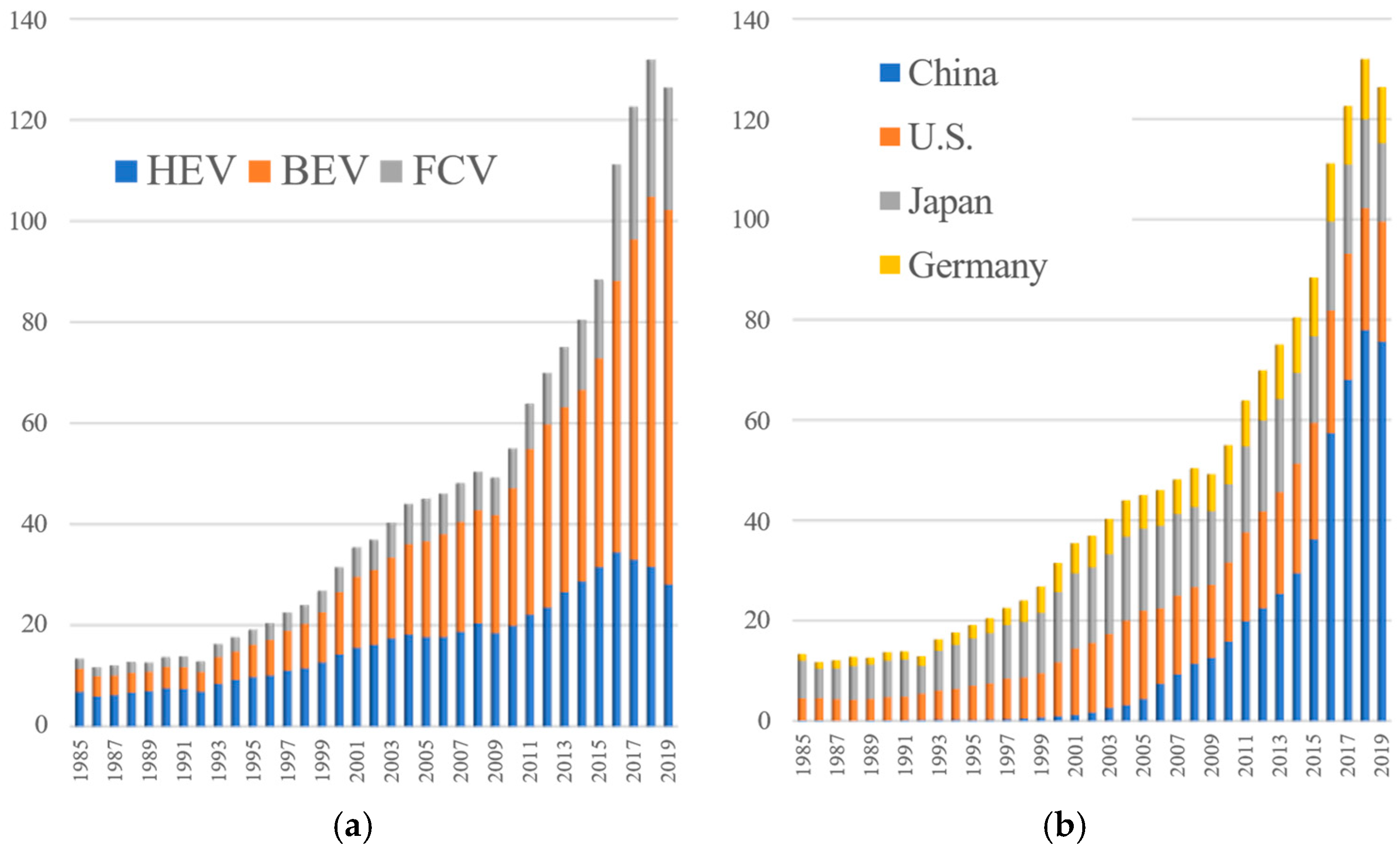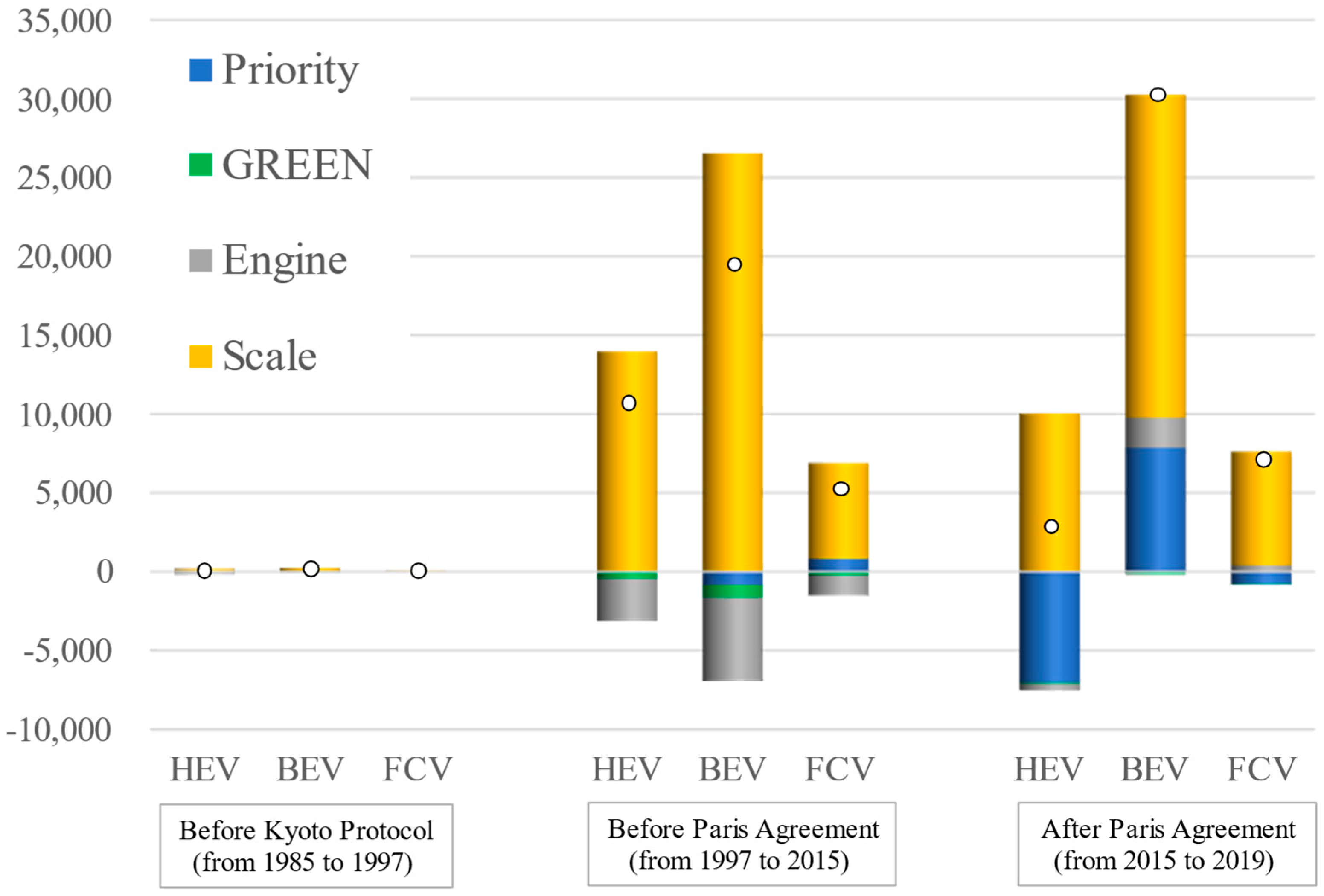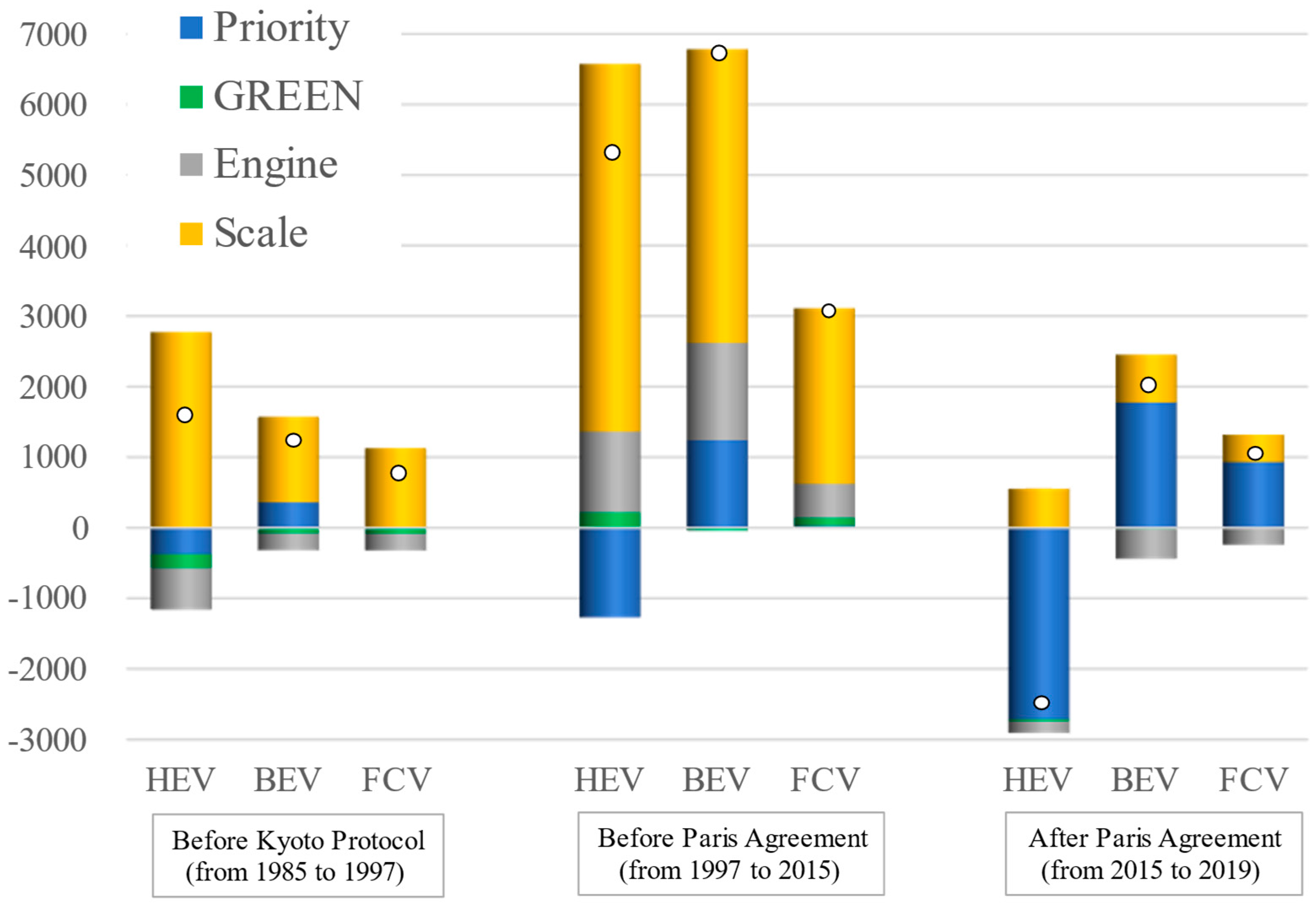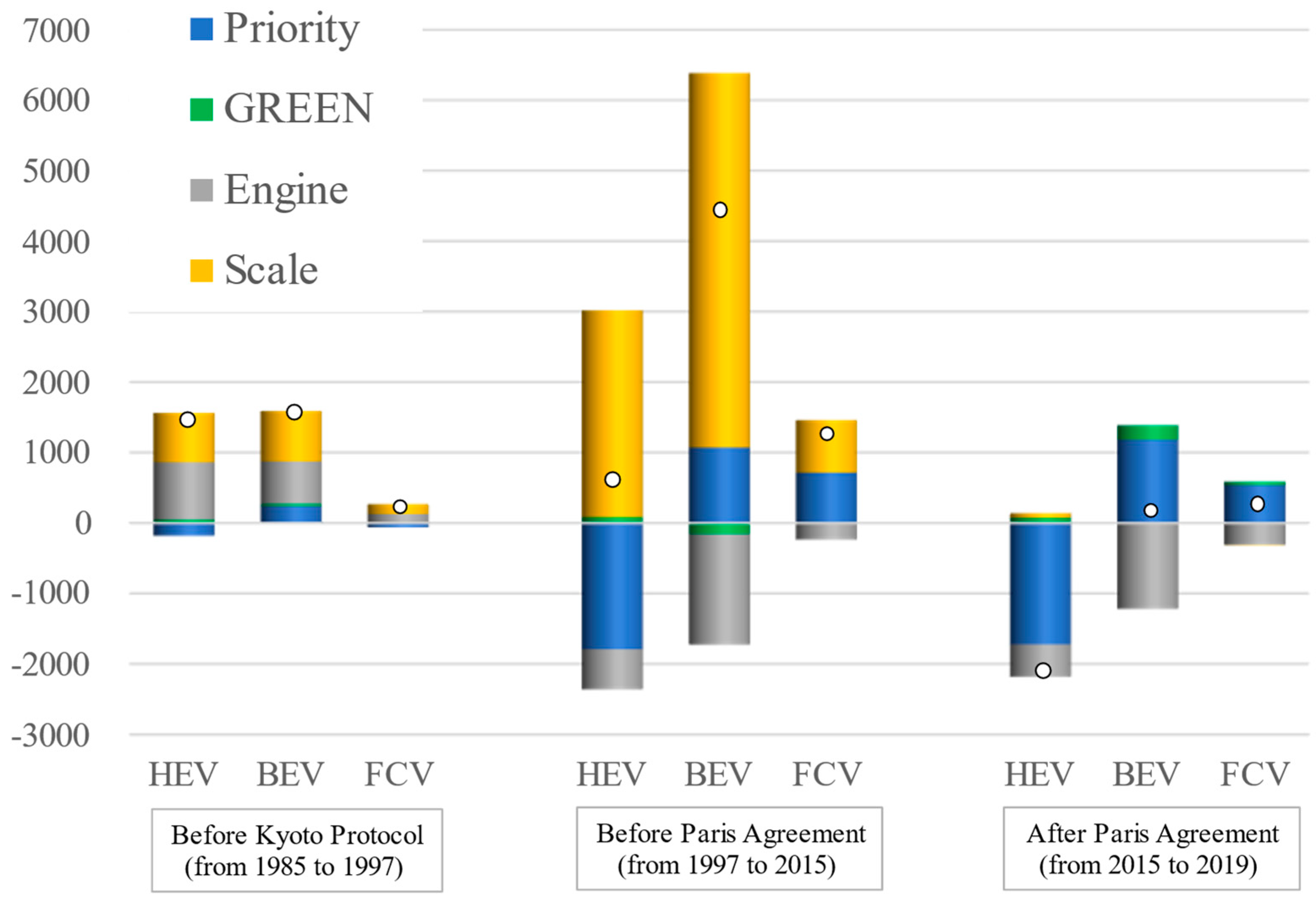A Global Analysis of Patent Invention Strategies in Automotive Technologies for Environmental Sustainability
Abstract
1. Introduction
2. Materials and Methods
2.1. Government Regulations and Green Automobile Technology R&D
2.2. Technological Changes and Temporal Patent Data
3. Methodology
4. Data
5. Results and Discussion
5.1. Decomposition Analysis
5.2. Regional Analysis with Structure Breaks
6. Conclusions and Policy Implications
6.1. Conclusion Remarks
6.2. Policy Implications
6.3. Limitation and Future Work
Author Contributions
Funding
Institutional Review Board Statement
Informed Consent Statement
Data Availability Statement
Conflicts of Interest
Appendix A. Description of Patent Data
| IPC | Description |
|---|---|
| B60K | Arrangement or mounting of propulsion units or transmissions in vehicles; arrangement or mounting of plural diverse prime movers in vehicles; auxiliary drives for vehicles; instrumentation or dashboards for vehicles; arrangements in connection with cooling, air intake, gas exhaust or fuel supply of propulsion units in vehicles |
| B60L | Propulsion of electrically propelled vehicles |
| B60W | Conjoint control of vehicle sub-units of different types or different functions; control systems specially adapted for hybrid vehicles; road vehicle drive control systems for purposes not related to the control of a particular sub-unit |
| F02B | Internal-combustion piston engines; combustion engines in general |
| F02D | Controlling combustion engines |
| F02F | Cylinders, pistons, or casings for combustion engines; arrangements of sealings in combustion engines |
| F02M | Supplying combustion engines, in general, with combustible mixtures or constituents |
| F02N | Starting of combustion engines; starting aids for such engines, not otherwise provided for |
| F02P | Ignition, other than compression ignition, for internal combustion engines; testing of ignition timing in compression–ignition engines |
| H01M | Processes or means, e.g., batteries, for the direct conversion of chemical energy into electrical energy |
References
- Avadikyan, A.; Llerena, P. A real options reasoning approach to hybrid vehicle investments. Technol. Forecast. Soc. Change 2010, 77, 649–661. [Google Scholar] [CrossRef]
- Ibanez-Fores, V.; Bovea, M.D.; Perez-Belis, V. A holistic review of applied methodologies for assessing and selecting the optimal technological alternative from a sustainability perspective. J. Clean. Prod. 2014, 70, 259–281. [Google Scholar] [CrossRef]
- Fujii, H.; Managi, S. Decomposition analysis of sustainable green technology inventions in China. Technol. Forecast. Soc. Change 2019, 139, 10–16. [Google Scholar] [CrossRef]
- Yuan, X.; Cai, Y. Forecasting the development trend of low emission vehicle technologies: Based on patent data. Technol. Forecast. Soc. Change 2021, 166, 120651. [Google Scholar] [CrossRef]
- Lin, C. 3 Drivers of China’s Booming Electric Vehicle Market. Operations Strategy. 2024. Available online: https://hbr.org/2024/01/3-drivers-of-chinas-booming-electric-vehicle-market (accessed on 1 February 2024).
- Chen, Y.H.; Chen, C.Y.; Lee, S.C. Technology forecasting and patent strategy of hydrogen energy and fuel cell technologies. Int. J. Hydrogen Energy 2011, 36, 6957–6969. [Google Scholar] [CrossRef]
- Sinigaglia, T.; Martins, M.E.S.; Siluk, J.C.M. The technological evolution of internal combustion engine vehicle: A patent data analysis. Appl. Energy 2022, 306, 118003. [Google Scholar] [CrossRef]
- Dijk, M.; Yarime, M. The emergence of hybrid-electric cars: Innovation path creation through co-evolution of supply and demand. Technol. Forecast. Soc. Change 2010, 77, 1371–1390. [Google Scholar] [CrossRef]
- Hashmi, A.R.; Biesebroeck, J.V. The relationship between market structure and innovation in industry equilibrium: A case study of the global automobile industry. Rev. Econ. Stat. 2016, 98, 192–208. [Google Scholar] [CrossRef]
- Bhatia, M.S.; Jakhar, S.K. The effect of environmental regulations, top management commitment, and organizational learning on green product innovation: Evidence from the automobile industry. Bus. Strategy Environ. 2021, 30, 3907–3918. [Google Scholar] [CrossRef]
- Ruoso, A.C.; Ribeiro, J.L.D. The influence of countries’ socioeconomic characteristics on the adoption of electric vehicle. Energy Sustain. Dev. 2022, 71, 251–262. [Google Scholar] [CrossRef]
- Dogan, E.; Ozturk, I. The influence of renewable and non-renewable energy consumption and real income on CO2 emissions in the USA: Evidence from structural break tests. Environ. Sci. Pollut. Res. 2017, 24, 10846–10854. [Google Scholar] [CrossRef]
- Fujii, H.; Yoshida, K.; Sugimura, K. Research and development strategy in biological technologies: A patent data analysis of Japanese manufacturing firms. Sustainability 2016, 8, 351. [Google Scholar] [CrossRef]
- WIPO. Patent Landscape Report-Hydrogen Fuel Cells in Transportation. 2022. Available online: https://www.wipo.int/publications/en/details.jsp?id=4604 (accessed on 10 April 2023).
- De Stefano, M.C.; Montes-Sancho, M.J.; Busch, T. A natural resource-based view of climate change: Innovation challenges in the automobile industry. J. Clean. Prod. 2016, 139, 1436–1448. [Google Scholar] [CrossRef]
- Fischer, C.; Newell, R.G. Environmental and technology policies for climate mitigation. J. Environ. Econ. Manag. 2008, 55, 142–162. [Google Scholar] [CrossRef]
- Zhao, J.H.; Zeng, D.L.; Che, L.P.; Zhou, T.W.; Hu, J.Y. Research on the profit change of new energy vehicle closed-loop supply chain members based on government subsidies. Environ. Technol. Innov. 2020, 19, 100937. [Google Scholar] [CrossRef]
- Burke, A.F.; Zhao, J.; Miller, M.R.; Sinha, A.; Fulton, L.M. Projections of the costs of medium-and heavy-duty battery-electric and fuel cell vehicles (2020–2040) and related economic issues. Energy Sustain. Dev. 2023, 77, 101343. [Google Scholar] [CrossRef]
- Kim, J.E. Energy security and climate change: How oil endowment influences alternative vehicle innovation. Energy Policy 2014, 66, 400–410. [Google Scholar] [CrossRef]
- Plan, R. Communication from the Commission to the European Parliament, the European Council, the Council, the European Economic and Social Committee and the Committee of the Regions; European Commission: Brussels, Belgium, 2018. [Google Scholar]
- da Silva Hyldmo, H.; Rye, S.A.; Vela-Almeida, D. A globally just and inclusive transition? Questioning policy representations of the European Green Deal. Glob. Environ. Change 2024, 89, 102946. [Google Scholar] [CrossRef]
- Witajewska-Baltvilka, B.; Helepciuc, F.E.; Mangalagiu, D.; Todor, A. Politicization of climate change and Central and Eastern European countries’ stance towards the European Green Deal. Glob. Environ. Change 2024, 89, 102932. [Google Scholar] [CrossRef]
- Gauto, M.A.; Carazzolle, M.F.; Rodrigues ME, P.; de Abreu, R.S.; Pereira, T.C.; Pereira GA, G. Hybrid vigor: Why hybrids with sustainable biofuels are better than pure electric vehicles. Energy Sustain. Dev. 2023, 76, 101261. [Google Scholar] [CrossRef]
- Van den Hoed, R. Sources of radical technological innovation: The emergence of fuel cell technology in the automotive industry. J. Clean. Prod. 2007, 15, 1014–1021. [Google Scholar] [CrossRef]
- Chan, C.C. The state of the art of electric, hybrid, and fuel cell vehicles. Proc. IEEE 2007, 95, 704–718. [Google Scholar] [CrossRef]
- Rashid, S.; Pagone, E. Cradle-to-Grave Lifecycle Environmental Assessment of Hybrid Electric Vehicles. Sustainability 2023, 15, 11027. [Google Scholar] [CrossRef]
- Koroma, M.S.; Costa, D.; Philippot, M.; Cardellini, G.; Hosen, M.S.; Coosemans, T.; Messagie, M. Life cycle assessment of battery electric vehicles: Implications of future electricity mix and different battery end-of-life management. Sci. Total Environ. 2022, 831, 154859. [Google Scholar] [CrossRef] [PubMed]
- Cho, Y. Investigating the merge of exploratory and normative technology forecasting methods. In 2013 Proceedings of PICMET’13: Technology Management in the IT-Driven Services (PICMET), San Jose, CA, USA, 28 July–1 August 2013; IEEE: New York, NY, USA, 2013; pp. 2083–2092. [Google Scholar]
- Choi, C.; Park, Y. Monitoring the organic structure of technology based on the patent development paths. Technol. Forecast. Soc. Change 2009, 76, 754–768. [Google Scholar] [CrossRef]
- Hirschey, M.; Richardson, V.J. Are scientific indicators of patent quality useful to investors? J. Empir. Financ. 2004, 11, 91–107. [Google Scholar] [CrossRef]
- Lee, C.; Kang, B.; Shin, J. Novelty-focused patent mapping for technology opportunity analysis. Technol. Forecast. Soc. Change 2015, 90, 355–365. [Google Scholar] [CrossRef]
- Levitas, E.F.; McFadyen, M.A.; Loree, D. Survival and the introduction of new technology: A patent analysis in the integrated circuit industry. J. Eng. Technol. Manag. 2006, 23, 182–201. [Google Scholar] [CrossRef]
- Nerheim, A.R. Maritime LNG fuel systems for small vessels—A survey of patents. Transp. Res. Part D Transp. Environ. 2023, 119, 103766. [Google Scholar] [CrossRef]
- Oltra, V.; Saint Jean, M. Variety of technological trajectories in low emission vehicles (LEVs): A patent data analysis. J. Clean. Prod. 2009, 17, 201–213. [Google Scholar] [CrossRef]
- Bonilla, D.; Bishop, J.D.; Axon, C.J.; Banister, D. Innovation, the diesel engine and vehicle markets: Evidence from OECD engine patents. Transp. Res. Part D Transp. Environ. 2014, 27, 51–58. [Google Scholar] [CrossRef]
- Aaldering, L.J.; Leker, J.; Song, C.H. Competition or collaboration?–analysis of technological knowledge ecosystem within the field of alternative powertrain systems: A patent-based approach. J. Clean. Prod. 2019, 212, 362–371. [Google Scholar] [CrossRef]
- Phirouzabadi, A.M.; Blackmore, K.; Savage, D.; Juniper, J. On the coexistence of positive and negative externalities in the inter-powertrain relationships. J. Clean. Prod. 2020, 277, 124118. [Google Scholar] [CrossRef]
- Lin, S.; Long, X.; Huang, J.; Gao, R. Green technology diversification, technology vertical spillovers, and energy intensity in Chinese cities. Energy Sustain. Dev. 2023, 76, 101281. [Google Scholar] [CrossRef]
- Fujii, H.; Managi, S. Research and development strategy for environmental technology in Japan: A comparative study of the private and public sectors. Technol. Forecast. Soc. Change 2016, 112, 293–302. [Google Scholar] [CrossRef]
- Wesseling, J.H.; Faber, J.; Hekkert, M.P. How competitive forces sustain electric vehicle development. Technol. Forecast. Soc. Change 2024, 81, 154–164. [Google Scholar] [CrossRef]
- Ha, S.H.; Liu, W.; Cho, H.; Kim, S.H. Technological advances in the fuel cell vehicle: Patent portfolio management. Technol. Forecast. Soc. Change 2015, 100, 277–289. [Google Scholar] [CrossRef]
- Ang, B.W.; Zhang, F.Q.; Choi, K.H. Factorizing changes in energy and environmental indicators through decomposition. Energy 1998, 23, 489–495. [Google Scholar] [CrossRef]
- Yamashita, A.S.; Fujii, H. Trend and priority change of climate change mitigation technology in the global mining sector. Resour. Policy 2022, 78, 102870. [Google Scholar] [CrossRef]
- Fujii, H.; Managi, S. Trends and priority shifts in artificial intelligence technology invention: A global patent analysis. Econ. Anal. Policy 2018, 58, 60–69. [Google Scholar] [CrossRef]
- Chen, Y.; Lin, B. Decomposition analysis of patenting in renewable energy technologies: From an extended LMDI approach perspective based on three Five-Year Plan periods in China. J. Clean. Prod. 2020, 269, 122402. [Google Scholar] [CrossRef]
- Baumann, M.; Domnik, T.; Haase, M.; Wulf, C.; Emmerich, P.; Rösch, C.; Zapp, P.; Naegler, T.; Weil, M. Comparative patent analysis for the identification of global research trends for the case of battery storage, hydrogen and bioenergy. Technol. Forecast. Soc. Change 2021, 165, 120505. [Google Scholar] [CrossRef]
- Fong, P.S.W.; Chang, X.; Chen, Q. Faculty patent assignment in the Chinese mainland: Evidence from the top 35 patent application universities. J. Technol. Transf. 2018, 43, 69–95. [Google Scholar] [CrossRef]
- SC. China’s National Medium and Long Term Science and Technology Development Planning (In Chinese), The State Council of the People’s Republic of China. 2006. Available online: http://www.gov.cn/gongbao/content/2006/content_240244.htm (accessed on 19 September 2022).
- Feng, X. The interaction between enhancing the capacity for independent innovation and patent protection: A perspective on the third amendment to the patent law of PR China. Pittsburgh J. Technol. Law Policy 2009, 9, 1. [Google Scholar]
- Bai, J.; Perron, P. Computation and analysis of multiple structural change models. J. Appl. Econom. 2003, 18, 1–22. [Google Scholar] [CrossRef]
- SC. Guiding Opinions on Accelerating the Promotion and Application of New Energy Vehicles (In Chinese), The State Council of the People’s Republic of China. 2014. Available online: http://www.gov.cn/xinwen/2014-07/21/content_2720944.htm (accessed on 19 September 2022).
- EPA. Final Rule for Control of Air Pollution from New Motor Vehicles: Tier 2 Motor Vehicle Emissions Standards and Gasoline Sulfur Control Requirements, The U.S. Environmental Protection Agency. 2000. Available online: https://www.epa.gov/regulations-emissions-vehicles-and-engines/final-rule-control-air-pollution-new-motor-vehicles-tier (accessed on 19 December 2022).
- Zhu, Y.; Wu, J.; Gaidai, O. The technology innovation of hybrid electric vehicles: A patent-based study. World Electr. Veh. J. 2024, 15, 329. [Google Scholar] [CrossRef]
- Sun, M.; Tong, T.; Jiang, M.; Zhu, J.X. Innovation trends and evolutionary paths of green fuel technologies in maritime field: A global patent review. Int. J. Hydrogen Energy 2024, 71, 528–540. [Google Scholar] [CrossRef]
- BP. BP Statistical Review of World Energy 2015. 2015. Available online: http://www.bp.com/statisticalreview (accessed on 19 September 2022).
- Bang, G. The US Inflation Reduction Act: Climate policy as economic crisis response. Environ. Politics 2024, 1–22. [Google Scholar] [CrossRef]
- Zhou, X.; Cai, Z.; Tan, K.H.; Zhang, L.; Du, J.; Song, M. Technological innovation and structural change for economic development in China as an emerging market. Technol. Forecast. Soc. Change 2021, 167, 120671. [Google Scholar] [CrossRef]
- Zhao, Z.; Huang, R.; Zhang, Y.; Shiga, Y.; Shaw, R. Assessing the Role of Climate Transition Bonds in Advancing Green Transformations in Japan. Climate 2024, 12, 201. [Google Scholar] [CrossRef]
- Germann, J. Global rivalries, corporate interests and Germany’s ‘National Industrial Strategy 2030’. Rev. Int. Political Econ. 2023, 30, 1749–1775. [Google Scholar] [CrossRef]
- Diversigy. Exploring Global Energy Investment Trends: Insights for Commercial Buyers and Stakeholders, Diversegy. 2024. Available online: https://diversegy.com/global-energy-investment-trends-2025/ (accessed on 4 January 2025).






| Technology Group | Tag | Description (Search Strategy) |
|---|---|---|
| (Green AET) AET related to battery electric vehicles | BEV | Technologies for electric propulsion, devices, among others relating to vehicles. Keywords: “electric vehicle”; “electric automobile”; “electric car” IPC codes: H02k; H01M; B60L011; B60L003; B60L015; B60K00101; B60W001008; B60W001024; B60W001026 |
| (Green AET) AET related to hybrid electric vehicles | HEV | Technologies for plural, diverse prime movers for mutual propulsion relating to vehicles. Keywords: “hybrid propulsion”; “hybrid electric vehicle”; “hybrid vehicle”; “hybrid automobile”; “hybrid electric car”; “hybrid car” IPC codes: F02; F16H; B60K006; B60W020; B60L00071; B60L000720 |
| (Green AET) AET related to fuel cell vehicles | FCV | Technologies for control and power supply from hydrogen fuel cells relating to vehicles. Keywords: “hydrogen” IPC codes: B60Y2200/10; B62; G01R 31/006; G05D2201/0213%; Y02T 10; B60W2510/28; B60W2710/28; Y02T 90/14; Y02T 90/34 |
| (Non-green AET) AET related to internal combustion engine vehicles | ICEV | Technologies for internal combustion engines and their accessories relating to vehicles. Keywords: “internal combustion engine”; “diesel engine”; “IC engine” IPC codes: F01; B60; F02B; F02D; F02F; F02M; F02N; F02P |
| Country | Variables | HEV | BEV | FCV |
|---|---|---|---|---|
| China | Patent | 2009(U), 2015(L) | 2005(U), 2010(U), 2015(U) | 2008(U), 2015(U) |
| Priority | 2015(L) | 2015(U) | - | |
| Green | - | - | - | |
| Engine | - | - | - | |
| Scale | 2013(U) | 2013(U) | 2013(U) | |
| United States | Patent | 1995(U), 2000(U), 2012(U) | 1995(U), 2001(U), 2010(U), 2015(U) | 1995(U), 2001(U), 2015(U) |
| Priority | 2015(L) | 1991(U), 1997(U), 2003(U), 2009(U), 2015(U) | 2001(U), 2006(L), 2013(U) | |
| Green | 2011(L) | 1995(U), 2001(U), 2006(U), 2011(U) | 2011(L) | |
| Engine | - | 2001(U), 2006(U), 2015(L) | - | |
| Scale | 2001(U), 2006(L) | 1993(L), 2006(L), 2011(U), 2016(U) | 2001(U), 2006(L), 2011(U) | |
| Japan | Patent | 1994(U), 2000(U), 2015(L) | 1995(U), 2000(U), 2005(U), 2011(U) | 1995(U), 2000(U), 2013(U) |
| Priority | - | - | - | |
| Green | - | - | - | |
| Engine | 2004(L) | 2012(L) | 2012(L) | |
| Scale | - | - | - | |
| Germany | Patent | 1994(U), 1999(U), 2008(U), 2013(L) | 1999(U), 2011(U) | 1993(U), 1998(U), 2003(U), 2012(U) |
| Priority | 2015(L) | - | 2001(U), 2005(L), 2009(U) | |
| Green | 2001(L), 2005(U), 2012(L) | 2013(L) | 2013(L) | |
| Engine | - | - | - | |
| Scale | - | - | - |
Disclaimer/Publisher’s Note: The statements, opinions and data contained in all publications are solely those of the individual author(s) and contributor(s) and not of MDPI and/or the editor(s). MDPI and/or the editor(s) disclaim responsibility for any injury to people or property resulting from any ideas, methods, instructions or products referred to in the content. |
© 2025 by the authors. Licensee MDPI, Basel, Switzerland. This article is an open access article distributed under the terms and conditions of the Creative Commons Attribution (CC BY) license (https://creativecommons.org/licenses/by/4.0/).
Share and Cite
Zhang, Z.; Fujii, H. A Global Analysis of Patent Invention Strategies in Automotive Technologies for Environmental Sustainability. Sustainability 2025, 17, 696. https://doi.org/10.3390/su17020696
Zhang Z, Fujii H. A Global Analysis of Patent Invention Strategies in Automotive Technologies for Environmental Sustainability. Sustainability. 2025; 17(2):696. https://doi.org/10.3390/su17020696
Chicago/Turabian StyleZhang, Zheng, and Hidemichi Fujii. 2025. "A Global Analysis of Patent Invention Strategies in Automotive Technologies for Environmental Sustainability" Sustainability 17, no. 2: 696. https://doi.org/10.3390/su17020696
APA StyleZhang, Z., & Fujii, H. (2025). A Global Analysis of Patent Invention Strategies in Automotive Technologies for Environmental Sustainability. Sustainability, 17(2), 696. https://doi.org/10.3390/su17020696




